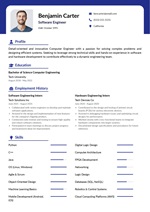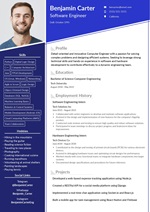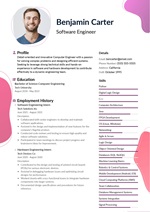In the competitive world of job hunting, your Resume is your first impression. It's the document that can either open doors to new opportunities or leave you stuck in the queue of overlooked candidates. Therefore, understanding the various types and formats of resumes is crucial in crafting a document that effectively showcases your skills, experiences, and accomplishments. Let's delve into the realm of resumes and explore the diverse types and formats to help you create the perfect one for your next career move.
Understanding Resume Types:
-
Chronological Resume: The chronological resume is the most traditional and widely used format. It presents your work history in reverse chronological order, starting with your most recent position and working backward. This type of resume highlights your career progression and demonstrates stability and growth in your professional journey. It's ideal for individuals with a consistent work history and those aiming for a job within the same field or industry.
-
Functional Resume: Unlike the chronological resume, the functional resume focuses on your skills and qualifications rather than your work history. It's particularly useful for candidates with employment gaps, career changers, or those with diverse experiences. A functional resume allows you to emphasize your relevant skills and achievements upfront, making it easier for recruiters to quickly assess your suitability for the position. However, it may raise concerns about transparency regarding your work history, so it's essential to provide a brief employment history section.
-
Combination Resume: As the name suggests, the combination resume blends elements of both the chronological and functional formats. It provides a comprehensive overview of your skills, experiences, and achievements while also showcasing your work history in chronological order. This type of resume is versatile and allows you to highlight your key qualifications while providing context through your work experience. It's suitable for candidates who want to emphasize specific skills and accomplishments while also showcasing their career progression.
-
Targeted Resume: A targeted resume is customized for a specific job or industry. Instead of creating a generic document, you tailor your resume to align with the requirements and preferences of a particular job posting. This involves carefully selecting and emphasizing relevant skills, experiences, and achievements that directly relate to the position you're applying for. A targeted resume demonstrates your genuine interest in the role and increases your chances of catching the recruiter's attention.
-
Infographic Resume: In the digital age, visual resumes have become increasingly popular. An infographic resume combines text and graphics to present information in a visually appealing and engaging manner. It allows you to showcase your creativity, design skills, and personality while still providing essential details about your qualifications and experiences. However, it's essential to ensure that the design elements enhance rather than detract from the content of your resume. Infographic resumes are best suited for creative fields such as graphic design, marketing, or advertising.
Exploring Resume Formats:
-
Standard Format: The standard format follows a conventional layout with clear sections such as contact information, professional summary or objective, work experience, education, and skills. It's clean, easy to read, and suitable for most industries and job applications. The standard format provides a structured framework for organizing your information, making it easier for recruiters to navigate your resume and locate relevant details.
-
Creative Format: A creative resume format allows you to break free from the constraints of traditional layouts and experiment with unconventional designs and styles. It's an opportunity to showcase your personality, creativity, and unique skills in a visually striking manner. Creative formats may include elements such as color, graphics, unconventional fonts, and innovative layouts. While a creative resume can help you stand out from the crowd, it's essential to strike a balance between creativity and professionalism to ensure that your resume remains professional and easy to read.
-
ATS-Friendly Format: Applicant Tracking Systems (ATS) are used by many companies to manage and filter incoming resumes. An ATS-friendly format is optimized to ensure that your resume can be accurately parsed and read by these systems. This involves using standard fonts, avoiding excessive formatting, including relevant keywords, and saving your resume in a compatible file format such as .docx or .pdf. By adhering to ATS guidelines, you increase the likelihood of your resume making it past the initial screening process and reaching the hands of a human recruiter.
-
Online Profile Format: With the rise of professional networking sites such as LinkedIn, many job seekers opt for an online profile format in addition to or instead of a traditional resume. An online profile allows you to create a dynamic and interactive representation of your professional identity, complete with endorsements, recommendations, and multimedia content. It provides a more holistic view of your skills and experiences and allows recruiters to engage with your profile in real-time. An online profile is particularly valuable for networking and building connections within your industry.
Tips for Crafting the Perfect Resume:
-
Tailor Your Resume: Customize your resume for each job application by highlighting relevant skills, experiences, and achievements that align with the job requirements.
-
Focus on Results: Quantify your achievements and provide specific examples of how you contributed to your previous employers' success. Focus on the outcomes and impact of your actions.
-
Keep it Concise: Aim for a resume length of one to two pages, depending on your level of experience. Be concise and prioritize information that is most relevant to the job you're applying for.
-
Use Action Words: Start bullet points with action verbs to convey a sense of action, initiative, and accomplishment. Avoid passive language and be specific about your contributions.
-
Proofread Carefully: Check for spelling and grammar errors, formatting inconsistencies, and typos. A well-polished resume demonstrates attention to detail and professionalism.
In conclusion, crafting an effective resume requires careful consideration of both the type and format that best showcase your qualifications and experiences. Whether you opt for a traditional chronological resume, a creative infographic format, or a targeted online profile, the key is to tailor your resume to the specific requirements of the job and industry you're targeting. By understanding the nuances of different resume types and formats, you can create a compelling document that sets you apart from the competition and paves the way for your next career move.






